.
The fall of the Roman Empire
brought in the age of a new power, that of the Christian Church. Since the
Christians had completely different concerns than the Roman republic, their
art took on an entirely different direction. It became much less focused
on realism, and more concerned with symbolic representations of Christian
concepts. All art served the role of church decoration. This helped to set
an atmosphere of devotion, while illustrating Christian stories to a largely
illiterate public. The first period of Medieval art is called the Byzantine (after the original name of Constantinople: Byzantium).
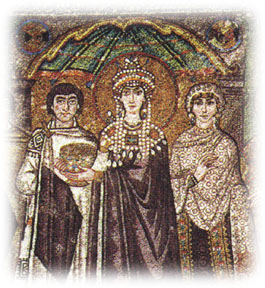
Empress Theodora, 547 |
The primary
medium of Byzantine art was their use of glass mosaics. The Romans had
used tiny stones to create mosaics, but the Byzantine artists used small
pieces of colored glass, set into the mortar of the church walls at
different angles to catch the light. The style is highly decorative,
symbolic, and flattened representations of Christian saints. The gold
backgrounds are intended to give an heavenly atmosphere, and figures
often have halos to represent their divine status.Occasionally, the
Holy Roman Emperor or Empress are depicted, to show the unification
of the church and state. Here, the Empress Theodora holds a goblet,
representing the blood of Christ. Another mosaic within the church depicts
the Emperor, Justinian, holding bread, representing Christ's body. |
Icon Images
The Byzantine reliance on images
of Jesus and the saints opposes the second Commandment which states, "Thou
shalt not make graven images to worship", but the Church counsel decreed
that since Christ had been incarnated in human form, it was necessary to represent
him in the flesh. Images of Christ on the cross began in the 6th century.
In addition to mosaics, the medieval artists developed a new medium of painting
with egg tempera on a wood support. This technique requires mixing the pigment
with egg yolk, creating a permanent bond to the surface. Those intended to
hang within the church were of a fairly large scale, and smaller versions
were later created for personal devotion. The stylization is similar to those
found in the mosaics: flattened and symbolic representations of Jesus, Mary,
and saints, with halos and a gold background to symbolize their heavenly status. The image of Christ on the cross evolved from images with his eyes open (representing
his victory over death), to those with his eyes closed. Later representations
show his body slumped in death (as the focus shifts to empathy with Christ's
suffering).
 Cimabue
Cimabue
Madonna Enthroned, 1285 |
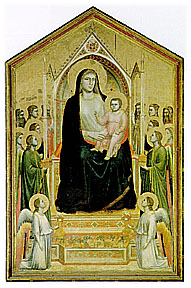 Giotto di Bondone
Giotto di Bondone
Madonna Enthroned, 1310 |
Images of Mary enthroned
as the heavenly mother of Christ was another popular icon. She is always the
center of the composition, and hierarchic scale also makes sure that she is
the focus of attention. The gold background reinforces her divine status, as
do the surrounding angels. There are strong similarities between these two images,
given the conventions that dictated her representation, but if you look carefully,
you will note that Giotto begins to define Mary in more three-dimensional terms.
We will see this tendency develop further as we move into the Renaissance period.
The "Animal
Style" and Illuminated Manuscripts
The animal style
is the artwork created by Northern nomadic peoples of ancient and medieval
Europe. They derive from
the Germanic and Nordic countries, which were barbaric tribes, until missionaries
christianized them during the Middle Ages. Since they had always been nomadic
people, their art was focused on things that they could carry, and were
generally functional objects (i.e., decorative swords, horse-trappings,
ship prows, etc). In general, their styles were based on animal imagery,
combined with an intricate interlacing of geometric lines. This style was
integrated into their Christian images, such as the Celtic Cross, and illuminated
page from the Book of Kells, below. Close inspection reveals delicate interlacing
lines and (in the case of the illuminated manuscript), human faces embedded
in the design.
Evolution
of Architectural Styles
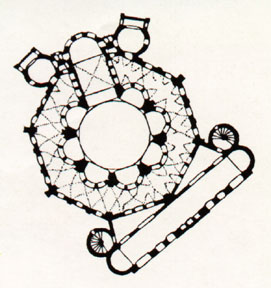
Central Plan |
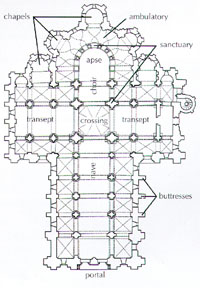
Basilica (Cross) Plan |
The
first Christian Churches generally followed the central plan in the east
(influenced by Roman temples, such as the Pantheon), and the basilica plan
in the west (a longitudinal plan with a transcept separating the altar from
the nave). Many of the eastern churches were transformed to Muslim mosques
when the Turks won the territory in 1453. Minarets
(small towers) and calligraphy from the Koran (the Moslem sacred book) replaced
Christian decorations in the Hagia Sophia, below. Throughout western Europe,
the basilica style eventually came to represent the image of the cross.
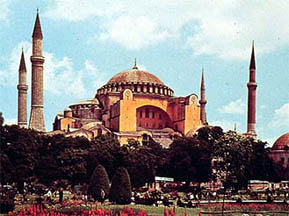
Hagia Sophia- Instanbul, Turkey
(previously Constantinople)
|
|
High Medieval
Period
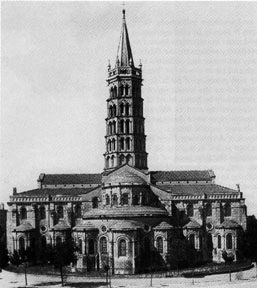
St. Sernin Cathedral
(Romanesque)
|
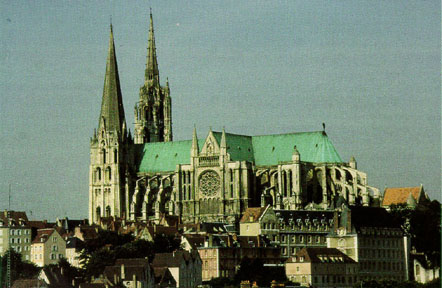
Notre Dame de Chartres Cathedral
(Gothic)
|
The "High Medieval Period" is first characterized by the Romanesque,
and then the Gothic styles of architecture. For many centuries, the Middle
Ages suffered from a lack of technical knowledge which the Romans had previously
achieved. The essential ingredient creating the bonding agent in concrete
had been forgotten, and churches were being built with wood roofs, which
were continually burning down. During a period of expanding interest in
religious pilgrimages, churches needed to be built which could contain growing
numbers of worshippers. Architects rediscovered Roman vaulting (utilizing
mortar to hold the stones in place, though concrete was not re-invented
until the 19th century). The vaulted arch allowed for a wider nave and sound
construction. St. Sernin is an example of Romanesque architecture. The walls
were massive stone blocks and the roof utilized the Roman semicircular arch.
Despite its lofty height, its massive structure makes it appear as though
it is "hugging the earth" (especially when viewed from the exterior).
The Romanesque had a symmetrical design, with a single tower, and was not
as highly decorative as the later, Gothic style.

Interior of St. Sernin
|
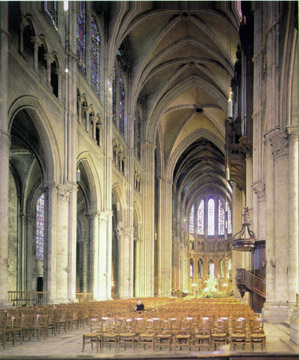
Interior of Chartres
|
Chartres Cathedral is an example
of gothic architecture in France (in Chartres, just outside of Paris). During
this period, architects make the greatest technical advances of Medieval
times. By devising a pointed arch, they are able to make walls which
are taller and thinner, creating the tallest buildings up to that time (and
not superceded until this century). The design opens up, allowing larger
windows, which they now decorate with colored glass. In addition, they have
devised a system for propping up the buildings with an exterior support
called "flying buttresses".
The gothic period
marks the highest point of Medieval art. Their huge churches are their greatest
masterworks, the crowning achievements of the Middle Ages. As the gothic period
progressed, the buildings continued to reach higher, and the decoration became
progressively elaborate. When one of the towers at Chartres Cathedral burnt
down, it was replaced with the later Gothic style (which is why it has an
asymmetrical appearance from the front). The church below is an extreme example
of High Gothic architecture. Notice the elaborate sculptures that fill every
surface.
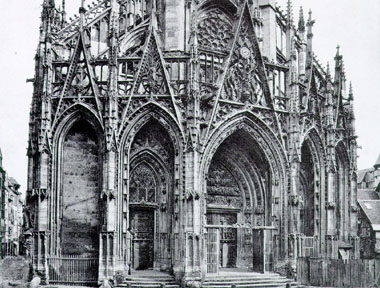
Architectural
Sculpture
Throughout the Middle
Ages, most sculpture is attached to the walls of the church. The cathedral
was a "sermon in stone" which could be "read" by an illiterate population.
Before a worshipper has even entered the church, he would find images of
saints and sinners, of angelic beings and the punishment of the damned.
All stood as a reminder of the importance of holding one's thoughts to God.
During the Romanesque period, there is a great similarity between images
from illuminated manuscripts and those depicted in their sculpture. Romanesque
design tends to be very flat, shallow reliefs of biblical stories and figures.
Gothic sculpture, on the other hand, tends to be much more three dimensional,
and the figures start to come to life. The full-volumed bodies carved on
the Chartres Cathedral, for instance, look as if they may walk off of the
building. In addition, the features are much more naturalistic: more human
and individualized. This trend will influence the beginnings of Renaissance
sculpture as well as painting.
Gargoyles
|
The original
purpose of a gargoyle was to drain water away from the sides of a building.
The word comes from the French "gargouille" which means "throat or pipe."
Many gargoyles fill this purpose, but others are purely decorative.The
images may relate to Europe's pagan past, combining various animal parts
in a grotesque fashion. One possible purpose for them is the belief
that frightening figures could scare away evil spirits. Another theory
is that they are reminders of the fate of sinners. |
|